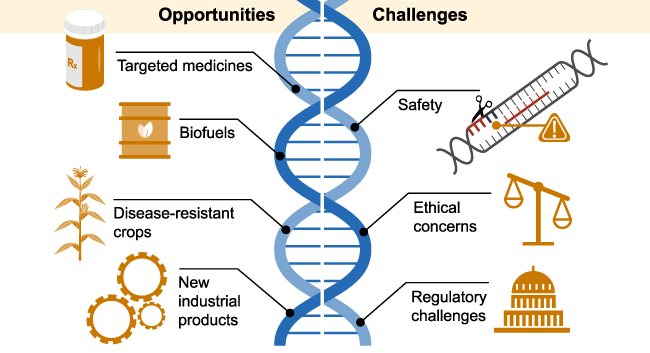Genome Editing | 01 Apr 2022
For Prelims: Site Directed Nuclease, Genetic Engineering Appraisal Committee, Deoxy-Ribonucleic Acid, GMO, Genome Editing.
For Mains: Genetic Engineering.
Why in News?
Recently, the Government has allowed genome-edited plants without the cumbersome GMO (Genetically Modified Organisms) regulation at the Genetic Engineering Appraisal Committee (GEAC).
- The government has exempted Site Directed Nuclease (SDN) 1 and 2 genomes from Rules 7-11 of the Environment Protection Act, thus allowing it to avoid a long process for approval of GM crops through the Genetic Engineering Appraisal Committee (GEAC).
- The Institutional BioSafety Committee (IBSC) under the Environment Protection Act would now be entrusted to certify that the genome edited crop is devoid of any foreign DNA.
What is the Genetic Engineering Appraisal Committee?
- It functions under the Ministry of Environment, Forest and Climate Change (MoEF&CC).
- It is responsible for the appraisal of activities involving large-scale use of hazardous microorganisms and recombinants in research and industrial production from the environmental angle.
- The committee is also responsible for the appraisal of proposals relating to the release of genetically engineered organisms and products into the environment including experimental field trials.
- GEAC is chaired by the Special Secretary/Additional Secretary of MoEF&CC and co-chaired by a representative from the Department of Biotechnology (DBT).
What is Genome Editing?
- Genome editing (also called gene editing) is a group of technologies that give scientists the ability to change an organism's Deoxy-Ribonucleic Acid (DNA).
- These technologies allow genetic material to be added, removed, or altered at particular locations in the genome.
- Advanced research has allowed scientists to develop the highly effective Clustered Regularly Interspaced Palindromic Repeat (CRISPR) -associated proteins based systems. This system allows for targeted intervention at the genome sequence.
- This tool has opened up various possibilities in plant breeding. Using this tool, agricultural scientists can now edit the genome to insert specific traits in the gene sequence.
- Depending on the nature of the edit that is carried out, the process is divided into three categories — SDN 1, SDN 2 and SDN 3.
- Site Directed Nuclease (SDN) 1 introduces changes in the host genome’s DNA through small insertions/deletions without introduction of foreign genetic material.
- In SDN 2, the edit involves using a small DNA template to generate specific changes. Both these processes do not involve alien genetic material and the end result is indistinguishable from conventionally bred crop varieties.
- The SDN3 process involves larger DNA elements or full length genes of foreign origin which makes it similar to Genetically modified organisms (GMO) development.
How is Gene Editing different from GMO development?
- Genetically Modified Organisms (GMO) involves modification of the genetic material of the host by introduction of a foreign genetic material.
- In the case of agriculture, soil bacteria is the best mining source for such genes which are then inserted into the host genome using genetic engineering.
- For example, in case of cotton, introduction of genes cry1Ac and cry2Ab mined from the soil bacterium Bacillus Thuringiensis (BT) allow the native cotton plant to generate endotoxins to fight pink bollworm naturally.
- BT Cotton uses this advantage to help farmers naturally fight pink bollworm which is the most common pest for cotton farmers.
- The basic difference between genome editing and genetic engineering is that while the former does not involve the introduction of foreign genetic material, the latter does.
- In the case of agriculture, both the techniques aim to generate variants which are better yielding and more resistant to biotic and abiotic stress.
- Before the advent of genetic engineering, such variety improvement was done through selective breeding which involved carefully crossing plants with specific traits to produce the desired trait in the offspring.
- Genetic engineering has not only made this work more accurate but has also allowed scientists to have greater control on trait development.
What are the Regulatory Issues Preventing the Technique?
- Across the world, GM crops have been a topic of debate, with many environmentalists opposing it on the grounds of bio safety and incomplete data. In India, the introduction of GM crops is a laborious process which involves multiple levels of checks.
- Till date the only crop which has crossed the regulatory red tape is Bt cotton.
- Scientists both in India and across the world have been quick to draw the line between GM crops and genome edited crops. The latter, they have pointed out, has no foreign genetic material in them which makes them indistinguishable from traditional hybrids.
- Globally, European Union countries have bracketed genome edited crops with GM crops. Countries like Argentina, Israel, US, Canada, etc have liberal regulations for genome edited crops.
UPSC Civil Services Examination, Previous Year Questions (PYQs)
Q. What is Cas9 protein that is often mentioned in news? (2019)
(a) A molecular scissors used in targeted gene editing
(b) A biosensor used in the accurate detection of pathogens in patients
(c) A gene that makes plants pest-resistant
(d) A herbicidal substance synthesized in genetically modified crops
Ans: (a)
EXP:
- CRISPR-Cas9 is a unique technology that enables geneticists and medical researchers to edit parts of the genome by removing, adding or altering sections of the DNA sequence.

